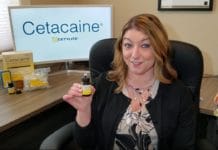Winter months bring not only holidays and celebrations but also the cold weather that can precipitate sinus issues, flu, colds, depression, and fatigue. Cold weather can also inadvertently cause complications of the mouth, such as xerostomia, hypersensitivity, and other abnormalities. Importantly, knowing the signs and symptoms will allow for the clinician to implement the proper patient education to combat the negative effects of cold weather for the dental patient.
Xerostomia (Dry Mouth)
Dental clinicians are aware of the effects of autoimmune disorders, medications such as beta-blockers, cancer treatments, and age as a precursor for xerostomia. However, cold weather can also be a cause of xerostomia, which is “a condition in which the salivary glands in your mouth don’t make enough saliva to keep the mouth wet.”1
Saliva is an important component in the mouth that prevents tooth decay, increases taste, enhances the ability to chew and swallow, as well as aiding in digestion. In reference to tooth decay, saliva neutralizes acids and, in return, limits bacterial growth by washing away food particles that can enhance bacterial growth. In addition, saliva contains enzymes that aid in the digestion of the food we consume.1
Unfortunately, the winter months bring cold air that holds less moisture, thus causing a decrease in humidity. Lower humidity then causes liquids to evaporate from the air and our body more quickly, which can result in a dry mouth.2 Inadvertently, the use of heat in our homes also aids in drier conditions by pumping dry air into the environment and then increasing the risk of xerostomia.
Sinus issues, the flu, colds, and heightened asthma conditions are more common during cold weather. Treatment of respiratory issues includes medications such as albuterol sulfate, cetirizine hydrochloride, loratadine, and loratadine with pseudoephedrine, to name a few. One side effect of all these medications is xerostomia. In addition, over-the-counter liquid medications for flu or sinus symptoms contain alcohol, which may also trigger xerostomia.3
The dental patient can combat xerostomia symptoms by increasing water intake and using a salivary enhancing treatment such as xylitol. Also, a humidifier or bowls of water throughout the house increase the moisture in the air to help prevent dry mouth.
More importantly, explain to patients how the use of medications with alcohol can increase dry mouth symptoms and may result in the risk of tooth decay. Lastly, advise the dental patient to avoid the use of sugar-enhanced cough drops, which is important in preventing future tooth decay.
Herpes Simplex Virus Type 1 (Cold Sores)
Dental patients also may experience herpes simplex virus type 1 (HSV-1) during winter months more frequently than in summer months. The cold conditions of the winter months may play a role due to the lack of sunlight, less physical activity, fatigue, as well as fevers caused by illness.
A cold sore (also called a “fever blister”) is a viral infection caused by the herpes simplex virus type 1 (HPV-1) that results in tiny, fluid-filled blisters on or around the lips that form in patches.4 Typically, cold sores heal in two to three weeks. Although there is no cure for a cold sore, the symptoms can be treated to decrease pain and healing time.4
Cold weather can increase the risk of a cold sore in many ways. First, illness resulting in a fever and weakened immunity can induce the presence of a cold sore. Secondly, the dry conditions of winter months and indoor heating can cause the lips to crack, and a loss of lubrication can precipitate a cold sore. As a result of the cold winter days, stress and fatigue may also enhance the risk of cold sores.5
Another cold-weather risk factor for cold sores is the lack of sunlight which can deplete vitamin D consumption, resulting in a longer healing time. Lastly, the increase of unhealthy food and alcohol consumption during holiday celebrations may decrease vitamin B, thus resulting in the presence of a cold sore.5
Although there is no cure for the cold sore, over-the-counter and prescription medications can aid in healing the symptoms. Educating the dental patient on the importance of nutrition, rest, decreased stress, and lip lubrication, such as lip balm, may prevent the occurrence of the cold sore.
It is recommended that the dental clinician not proceed with treatment when a cold sore is present. The contagious nature of the HSV-1 during viral shedding can pose a danger of spreading through saliva and aerosols to other areas of the body such as the eyes, even if wearing eye protection.6 If the eyes are infected, it can result in a condition called stromal keratitis that can cause infectious blindness.6
Perhaps the most dangerous complication of HSV-1 is herpes simplex encephalitis. While this condition is extremely rare, it is the most prevalent cause of encephalitis in America. High rates of mortality and morbidity are unavoidable, even with antiviral therapy. If encephalitis is left untreated, the mortality rate can approach 80% within a one- to two-week timeframe.”6
In addition, minute tears that are not visible to the naked eye could lead to herpetic whitlow for the clinician, and, with every outbreak, the clinician is unable to work for weeks.6 It should be noted that laser treatment of HSV-1 may expedite the healing process and reduce time; however, it does not eliminate the virus and viral shedding. Placing Vaseline on the lesion is not recommended as the virus is present in saliva, not just the lesion.
Therefore, reappointing the patient for at least two weeks or until the cold sore has completely healed is in the best interest of the patient and dental clinician.6
Hypersensitivity
A common complaint of dental patients is tooth sensitivity. Dentin hypersensitivity is “tooth pain resulting from exposure to cold temperatures, osmotic agents (e.g., sugars or other sweets), or touch. It is caused by exposure of dentinal tubules when cementum is worn off the outer layer of a tooth, e.g., in patients who have receding gums.”7
The effects of cold weather in relation to tooth hypersensitivity is a result of the hydrodynamic theory when the “fluid flows away from the dentin and pulp” when exposed to “cooling, drying, evaporation, and hypertonic chemicals.”8 These exposures result in an increase in pain.
During cold weather, the exposure of the dentinal tubule as a result of erosion, recession, and/or abrasion allows for penetration of cold air, resulting in increased tooth pain. As previously mentioned, the enhanced dry mouth may exacerbate the hypersensitivity.
Recommending treatment for hypersensitivity may include prescription or over-the-counter sensitivity toothpaste containing stannous fluoride or a high percentage of sodium fluoride. With respect to gingival recession, a more drastic treatment may include a gingival graph performed by a periodontist or a dentinal sensitivity in-office treatment.
Conclusion
Although winter and the cold weather can bring celebration and snowball fights, the ill effects on the oral cavity may be less than joyous. Therefore, a thorough oral assessment and medical assessment by the dental clinician may lead to the proper diagnosis, cause, and treatment of cold weather-induced oral complications, such as tooth sensitivity, cold sores, and xerostomia.
Need CE? Check Out the Self-Study CE Courses from Today’s RDH!
Listen to the Today’s RDH Dental Hygiene Podcast Below:
References
- Dry Mouth. (2018, February 1). Mayo Clinic. Retrieved from https://www.mayoclinic.org/diseases-conditions/dry-mouth/symptoms-causes/syc-20356048
- How Dry Winter Air Can Cause Respiratory Problems from Bronchitis to Nosebleeds. (2019, February 17). Cleveland Clinic. Retrieved from https://health.clevelandclinic.org/can-best-combat-effects-dry-winter-air/
- Christensen, G.J. Common Prescription Associated with Xerostomia. Clinicians Report. 2012; 5(10). Retrieved from https://www.cliniciansreport.org/uploads/files/55/Meds%20Cause%20Xerostomia.pdf
- Cold Sores. (2020, June 17). Mayo Clinic. Retrieved from https://www.mayoclinic.org/diseases-conditions/cold-sore/symptoms-causes/syc-20371017
- White, L. (2018, September 9). 9 Reasons for Cold Sores During Cold Weather (& How to Stay Safe)! Cold Sores Cured. Retrieved from https://www.coldsorescured.com/cold-sores-from-cold-weather/
- Vavrosky, K. (2018, January 1). Why Hygienists Should Never Treat Patients with Active Oral Herpes. Today’s RDH. Retrieved from https://www.todaysrdh.com/why-hygienists-should-never-treat-patients-with-active-oral-herpes/
- Dentine Hypersensitivity. (n.d.). The Free Dictionary. Retrieved from https://medical-dictionary.thefreedictionary.com/Dentin+hypersensitivity
- Davari, A.R., Ataei, E., Assarzadeh, H. Dentin Hypersensitivity: Etiology, Diagnosis and Treatment; A Literature Review. Journal of Dentistry Shiraz University of Medical Science. 2013 Sep; 14(3): 136–145. Retrieved from https://www.ncbi.nlm.nih.gov/pmc/articles/PMC3927677/












